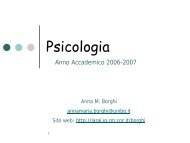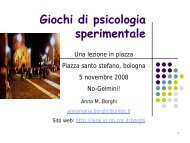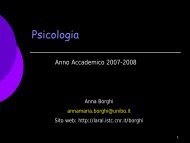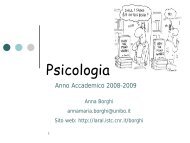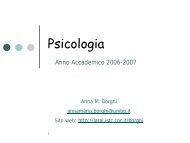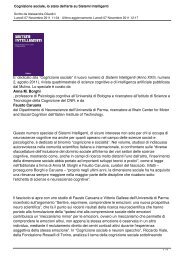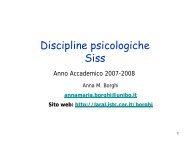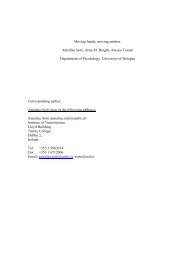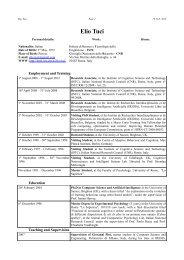Evolution of Artificial Neural Networks - laral
Evolution of Artificial Neural Networks - laral
Evolution of Artificial Neural Networks - laral
Create successful ePaper yourself
Turn your PDF publications into a flip-book with our unique Google optimized e-Paper software.
Nolfi and Parisi, <strong>Evolution</strong> <strong>of</strong> <strong>Artificial</strong> <strong>Neural</strong> <strong>Networks</strong> 6node <strong>of</strong> the tree and then following each ramification. The top node represents theinitial cell that, by undergoing a set <strong>of</strong> duplication processes, produces the finalneural network. Each node <strong>of</strong> the genotype tree encodes the operations that shouldbe applied to the corresponding cell and the two sub-trees <strong>of</strong> a node specify theoperations that should be applied to the two daughter cells. The neural network isprogressively built by following the tree and applying the correspondingduplication instructions. Terminal nodes <strong>of</strong> the tree (i.e. nodes that do not havesub-trees) represents terminal cells that will not undergo further duplications.Gruau also considered the case <strong>of</strong> genotypes formed by many trees where theterminal nodes <strong>of</strong> a tree may point to other trees. This mechanism allows thegenotype-to-phenotype process to produce repeated phenotypical structures (e.g.repeated neural sub-networks) by re-using the same genetic informations. Treesthat are pointed to more than once, in fact, will be executed more times. Thisencoding method has two advantages: (a) compact genotypes can producecomplex phenotypical networks, and (b) evolution may exploit phenotypes whererepeated sub-structures are encoded in a single part <strong>of</strong> the genotype. Since theidentification <strong>of</strong> sub-structures that are read more than once is an emergent result<strong>of</strong> the evolutionary process, Gruau defined this method Automatic Definition <strong>of</strong><strong>Neural</strong> Subnetworks (ADNS) (Gruau, 1994).Discussion<strong>Artificial</strong> evolution can be seen as a learning algorithm for training artificialneural networks. From this point <strong>of</strong> view, one distinctive feature is the limitedamount <strong>of</strong> feedback required. Supervised learning algorithms require immediateand detailed desired answers as a feedback. Reinforcement learning algorithmsrequire less - only a judgement <strong>of</strong> right or wrong which should not be necessarilyimmediate. Viewed as a learning algorithm, artificial evolution requires still less -only an overall evaluation <strong>of</strong> the performance <strong>of</strong> the network over the entireevaluation period. A second distinctive feature is that any parameter <strong>of</strong> the neuralnetwork (e.g. the connection strengths, the network topology, the learning rules,the transfer function <strong>of</strong> the neurons) can be subjected to the evolutionary process.Although systematic comparison between artificial evolution and otheralgorithms are not been done yet, it is reasonable to claim that artificial evolutiontend to produce better results when detailed feedback is not available. This is thecase, for example, <strong>of</strong> a neural networks that should control mobile robots (Nolfiand Floreano, 2000). In this case in fact, although the experimenter can provide ageneral evaluation <strong>of</strong> how much the behavior <strong>of</strong> a robot approximates the desiredbehavior, he or she cannot usually indicate what the robot should do each timestep to produce such a desired behavior. Moreover artificial evolution might resultmore effective in those cases in which certain features <strong>of</strong> the network (such as the



